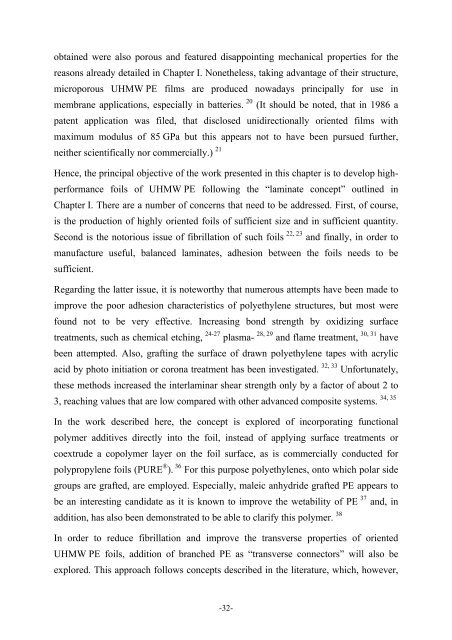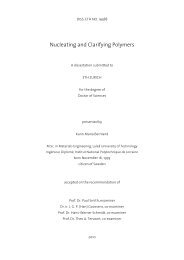4 Conclusions - POLYTECH - ETH Zürich
4 Conclusions - POLYTECH - ETH Zürich
4 Conclusions - POLYTECH - ETH Zürich
Create successful ePaper yourself
Turn your PDF publications into a flip-book with our unique Google optimized e-Paper software.
obtained were also porous and featured disappointing mechanical properties for thereasons already detailed in Chapter I. Nonetheless, taking advantage of their structure,microporous UHMW PE films are produced nowadays principally for use inmembrane applications, especially in batteries. 20 (It should be noted, that in 1986 apatent application was filed, that disclosed unidirectionally oriented films withmaximum modulus of 85 GPa but this appears not to have been pursued further,neither scientifically nor commercially.) 21Hence, the principal objective of the work presented in this chapter is to develop highperformancefoils of UHMW PE following the “laminate concept” outlined inChapter I. There are a number of concerns that need to be addressed. First, of course,is the production of highly oriented foils of sufficient size and in sufficient quantity.Second is the notorious issue of fibrillation of such foils 22, 23 and finally, in order tomanufacture useful, balanced laminates, adhesion between the foils needs to besufficient.Regarding the latter issue, it is noteworthy that numerous attempts have been made toimprove the poor adhesion characteristics of polyethylene structures, but most werefound not to be very effective. Increasing bond strength by oxidizing surfacetreatments, such as chemical etching, 24-27 plasma- 28, 29 and flame treatment, 30, 31 havebeen attempted. Also, grafting the surface of drawn polyethylene tapes with acrylicacid by photo initiation or corona treatment has been investigated. 32, 33 Unfortunately,these methods increased the interlaminar shear strength only by a factor of about 2 to3, reaching values that are low compared with other advanced composite systems.In the work described here, the concept is explored of incorporating functionalpolymer additives directly into the foil, instead of applying surface treatments orcoextrude a copolymer layer on the foil surface, as is commercially conducted forpolypropylene foils (PURE ® ). 36 For this purpose polyethylenes, onto which polar sidegroups are grafted, are employed. Especially, maleic anhydride grafted PE appears tobe an interesting candidate as it is known to improve the wetability of PE 37 and, inaddition, has also been demonstrated to be able to clarify this polymer. 38In order to reduce fibrillation and improve the transverse properties of orientedUHMW PE foils, addition of branched PE as “transverse connectors” will also beexplored. This approach follows concepts described in the literature, which, however,34, 35-32-




